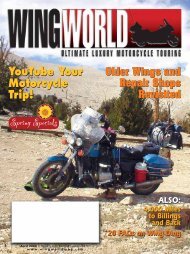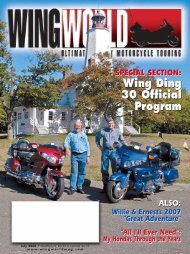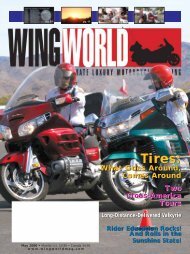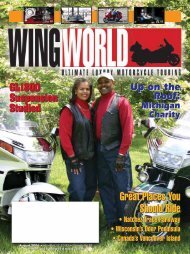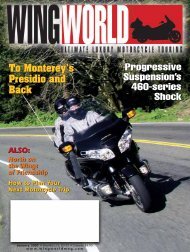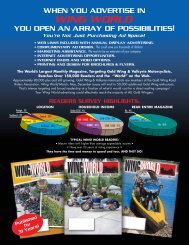to view pdf file of current issue - Wing World Magazine Archives
to view pdf file of current issue - Wing World Magazine Archives
to view pdf file of current issue - Wing World Magazine Archives
You also want an ePaper? Increase the reach of your titles
YUMPU automatically turns print PDFs into web optimized ePapers that Google loves.
John and Melinda’sfirst system—AM-FM-CB with a handmic and fairingspeakers.J&M tech Jim Vertz links a dongle with a headset.Blue<strong>to</strong>oth enabling <strong>of</strong> the mo<strong>to</strong>rcycle’s audiosystem. A dongle is also available for theJMCB2003—J&M’s add-on CB/weather radiowith aux input.Blue<strong>to</strong>oth Or Wired? First Things FirstJohn advises us that the most importantthing when deciding how <strong>to</strong> configure your<strong>Wing</strong>’s audio system is <strong>to</strong> determine whatthings you’ll add <strong>to</strong> the basic package.To facilitateadding components <strong>to</strong> the GL1800’saudio system, J&M <strong>of</strong>fers their CFRG-GL18integration terminal.This device provides integrationfor cell phones, radar detec<strong>to</strong>rs, andGPS units. Adding those additional units <strong>to</strong>the CFRG is accomplished with an appropriateJ&M adapter cable. Having accomplishedthe system configuration, one must nowdecide whether <strong>to</strong> listen and transmit wirelesslyor use the traditional headset cords—either way will work.Going BlueSo having configured our audio systemwith the added components and integratedthem using the CFRG, let’s say we’ve nowdecided <strong>to</strong> go wireless. What’s involved? TheAn improved earlysystem, with a boommic and intercom.helmet must connect wirelessly <strong>to</strong> the audiosystem, and vice versa.The first thing we need is the dongle <strong>to</strong>Blue<strong>to</strong>oth-enable the audio system. Thatwould be J&M’s Cus<strong>to</strong>m Dongle with JMAHPBlue<strong>to</strong>oth S<strong>of</strong>tware Pro<strong>file</strong> (JBLU-DNG03).This item mounts in the right fairing pocketfor theft protection. It’s powered by a lithiumion battery with about 30 hours continuousrun time, so that means using the included ACcharger while on a road trip. Why batterypowered? To eliminate the whine and otherinterference from outside electrical devicesand ground loops. Shielding would work, butFCC regulations demand that these devicesaccept all interference—go figure.Next, we’ll need <strong>to</strong> determine how wewant <strong>to</strong> connect <strong>to</strong> the cell phone—there arethree options. If using a Blue<strong>to</strong>oth enabledGPS like the Zumo in conjunction with theCFRG, we can pair our cell phone directly <strong>to</strong>the GPS. Otherwise, the CFRG gives two additionaloptions. Plug the CFRG directly in<strong>to</strong> thecell phone. Or, if the phone has no headsetjack, install J&M’s Blue<strong>to</strong>oth® Cell PhoneAdapter for J&M CFRG Modules (CFRG-BT01).This allows the cell phone <strong>to</strong> interfacewirelessly with the CFRG integration module.Finally, we need <strong>to</strong> decide on a Blue<strong>to</strong>othhelmet headset. As usual, J&M <strong>of</strong>fers units forinstallation in full face, flip style, and 3/4 stylehelmets <strong>of</strong> your choice. They also <strong>of</strong>fer inhouseinstallation in new Arai Pro<strong>file</strong> helmets,Arai XD3 helmets (more on this helmet in aminute), and Nolan N103 flip-style helmets.As seen in the pho<strong>to</strong>s, the Nolan unit issomewhat different and more integrated in<strong>to</strong>the helmet’s design thanks <strong>to</strong> cus<strong>to</strong>m partsmade <strong>to</strong> J&M’s specs that replace the lowertrim piece. All <strong>of</strong> these helmet headsets arebattery powered with a run time <strong>of</strong> around15 hours. Again, a full charge before beginninga day’s ride is highly recommended. Co-riderscan plug a coiled cord in<strong>to</strong> either the <strong>Wing</strong>’sstandard passenger audio outlet or a port inthe rider’s Blue<strong>to</strong>oth helmet. Or, they couldenjoy complete cordless freedom with thepurchase and installation <strong>of</strong> another dongle <strong>to</strong>Blue<strong>to</strong>oth-enable the rear seat audio feed.How Well Does It All Work?Let’s consider the new Arai XD3 helmetfirst.This helmet looks more like an <strong>of</strong>f-roadinghelmet than a street helmet, but don’t letthe looks fool you. Even when used on anaked street bike, the XD3 is the quietest helmetI’ve ever worn. Other benefits include abuilt on sun visor and Arai’s famously comfyinterior. When using the corded version andriding behind John on the passenger seat <strong>of</strong> aGL1800, the stereo music had outstandingfidelity with not a hint <strong>of</strong> wind noise up <strong>to</strong>around 65 miles per hour. Above that speed,minor wind noise could be heard, but it barelyaffected the music or intercom quality. Italso didn’t activate the au<strong>to</strong> mute function.Later, while riding in the pilot’s position, Is<strong>to</strong>od on the pegs at 75 miles per hour <strong>to</strong> getmy head directly in the wind stream. Again,March 2009 61



